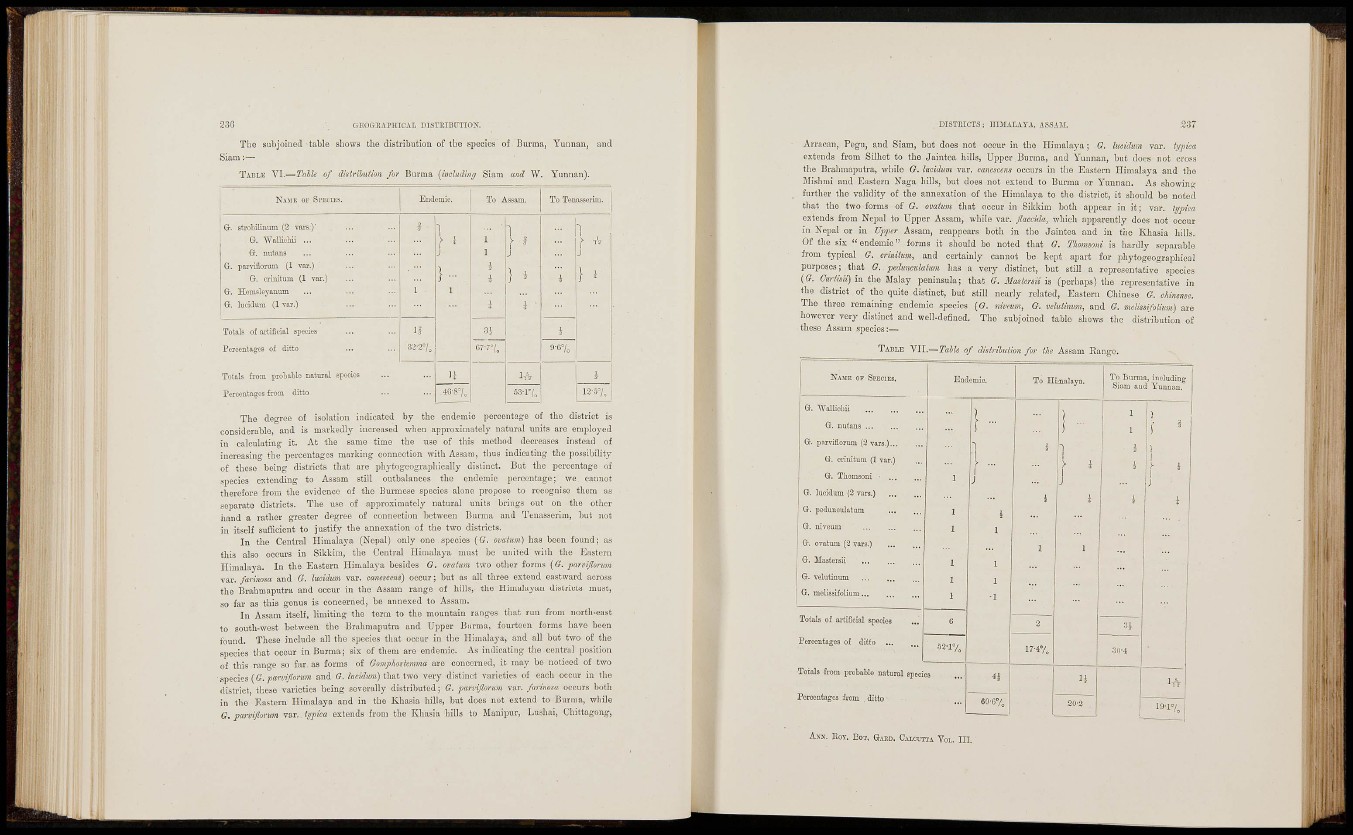
2 3 6 GEOGEAPHICAL DISriilBUTIOX
The subjoined table sliows the distribution of the specios of Burma, Yunnan, and
Siani:—
TABLU VI.—TahU of distribution for Burma {^including Siara and W. Yunnan).
N A M K OF SVECIES. Endemic, To Assam. To Tonnssoritn.
' G. stroliiinum (2 vars.)'
i G. "Wamcliii ...
G. nutans
G. paniflorum (1 var.)
G. ci'initum (1 var.)
G. Hemsleyfluum
G. lucidum (Ivor.)
1
1 1
1
1
i
i
Ì
} ^
1 •
J
J
} i
Totals of artificial species Vi i
Percentages of ditto 9 - C %
Totals from probaljle natural species 4
Percentages from ditto iS'S'j, 12-ö7„
The degree of isolation indicated by the endemic percentage of the district is
considerable, and is markedly increased when approximately natural units are employed
in calculating it. At the same time the use of this method decreases instead of
increasing the percentages marking connection with Assam, thus indicating the possibility
of these being districts that are phytogeogi'aphically distinct. But the percentage of
species extending to Assam still outbalances the endemic jjercentage; -we cannot
therefore from the evidence of the Burmese species alono propose to recognise them as
separate districts. The use of approximately natural units brings out on the other
hand a rather greater degree of connection between Burma and Tenasserim, hut not
in itself sufficient to justify the annexation of the two districts.
In the Central Himalaya (Nepal) only one species {(?. ovatim) has been found; as
this also occurs in Sikkim, the Central Himalaya must be united with the Eastern
Himalaya. In the Eastern Himalaya besides G. ovatum two other forms {G. parviflonm
rar. farinosa and G. lucidum var. canesccns) occur; but as all three extend eastward across
the Brahmaputra and occur in the Assam range of hills, the Himalayan districts must,
so far as this genus is concerned, be annexed to Assam.
In Assam itself, limiting the term to the mountain ranges that run from north-east
to south-west between the Brahmaputra and Upper Burma, fourteen forms havo been
found. These include all the species that occur in the Himalaya, and all but two of the
species that occur in Burma; six of them are endemic. As indicating the central position
of this range so far. as forms of Gomphostemmu are concerned, it may ho noticed of two
• sp^d'is. {G. parviflonm and G. ¿««'¿m) that two very distinct varieties of each occur in the
district, these varieties being severally distributed; G. parvijlorum var. farivosa occurs both
in the Eastern Himalaya and in the Khasia hills, but does not extend to Eurma, while
G. parviflorum var. iypica extends from the Khasia hills to Manipur, Lushai, Chittagong,
DISTIIICTS; HIMALAYA, ASSAM. 23 7
Arracan, Pegu, and Siam, but does not occur in tho Himalaya; G. lucidum var. ii/pica
extends from Silhet to the Jaintea hills, Upper Burma, and Yunnan, but docs not cross
the Brahmaputra, while G. hcidum var. canescens occurs in the Eastern Himalaya and tho
Mishnii and Eastern Naga hills, but docs not extend to Burma or Yunnan. As showing
further the validity of the annexation of the Himalaya to the district, it should be noted
that the two forms of G. ovaiwn that occur in Sikkim botli appear in it; var. iijpica
extends from Nepal to Upper Assam, while var. flaccida, which apparently does not occur
in Nepal or in Upper Assam, reappears both in the Jaintea and in the Khasia hills.
Of the six "endemic" forms it should be noted that G. Thomsoni is hardly separable
from typical G. crinitum, and certainly cannot be kept apart for phytogeographica 1
purposes; that G. pedunculatum has a very distinct, but still a representative species
((?. Curfmi) ia the Malay peninsula; that G. 31astersii is (perha2)s) the representative in
the district of the quite distinct, but still nearly related. Eastern Chinese G. chinense.
Tho three remaining endemic species {O. niveum, G. vduiinum, and G. vidissifolitmi) ai-e
however very distinct and well-defined. The subjoined table shows the distribution of
these Assam species:—
TABLE YYl.—Table of disinbution for ilic Assam Range.
NAJTE OF
G. Wallicbii
G", nutans ...
G. pnrviilorum (2 vai
G, criuitum (1
G. Tliomsoni •
G, lucidum (2 vars.)
G. pedunoulatum
G. niveum
G. OTatum (2 vars.)
G. Mastersii
G. velutittum
G. melissit'oliuiu...
Totals of ortiScial species
Percentages of ditto ...
Totals from probatle natural s
Percentages from, ditto 60-67^
To Ilijiainya. To Burma, including
S i am aud Yunnan."^
3i
iO-2
ItV
ASN. EOI. BOT. GAKD. C-vicvrcA VOL. HI.
I M
•R
m
r